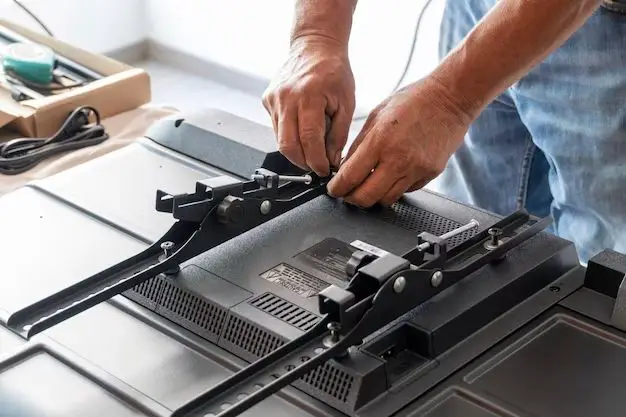There are a few key steps to feeding wires through the wall for a TV. First, you’ll need to determine where you want the TV mounted and where your devices will be located. This will tell you where you need to run cables. Next, you’ll need to cut holes in the drywall to route the cables between wall studs. Make sure not to cut into any plumbing or electrical lines hidden in the walls. Feeding the cables through the wall carefully and leaving extra length will make connecting devices easier. Using wall plates, conduit, and cable clips will keep everything tidy and protected. With some planning and care, you can route cables through walls for a clean, professional TV setup.
Page Contents
Where Should You Locate the TV and Devices?
When wiring a wall for a TV install, the first step is deciding where you want to mount the TV and where your playback devices will be located. Some key factors to consider for optimal setup:
- Eye level – Mount the TV so the center is at eye level when seated. This is typically 40-60 inches from the floor to the center of the screen.
- Viewing distance – Position seating 8-12 feet from a normal 50-60 inch TV for best viewing.
- Cable lengths – factor in the length of HDMI and other cables between devices when placing electronics.
- Power outlets – Ensure outlet access for TV, devices, speakers, etc.
- Focal point – Place the TV where it will be the natural focal point of the room when entering.
Locate all equipment like cable boxes, streaming devices, game systems, receivers, etc. within reach of where hidden cables will be routed. This could be in a nearby cabinet, media console, or wall-mounted enclosures. Think through the entire system early when deciding placement.
How to Cut Holes for Cables
Once you know the start and end points, it’s time to cut holes so you can route cables through stud walls or cavities. Follow these best practices:
- Locate studs – Use a stud finder to locate studs so you avoid drilling into them.
- Outlet height – Match the height of nearby outlets for a consistent look.
- Hole diameter – Cut holes 1 in. in diameter, large enough for connectors to pass through.
- Hole saw – Use a hole saw drill bit to cut clean, rounded openings.
- Vertical runs – Drill holes centered at least 1 ft. from the floor or ceiling for vertical runs.
- Fishing access – Consider cutting holes near the top and bottom to help fish wires.
Avoid plumbing or electrical – Use a cable scanner or metal detector to be sure you won’t cut into hidden pipes or wiring.
Fishing and Feeding Cables
Now that your access holes are cut, it’s time to fish the cables between them. Follow a careful process:
- Plan connections – Label cables and think through how they should be connected before fishing walls.
- Extra length – Leave at least 6 feet of extra cable at each access point to work with.
- Pull string – Use string or fishing tape between holes first to establish the path.
- Lubricate – Coat cables with wire pulling lubricant to reduce friction.
- Avoid staples – Don’t staple cables in place between holes or you’ll damage them.
- Glow rods – Use glowing fiberglass rods to visually see the path for fishing at night.
- Gradually feed – Have a partner gently feed cable as you pull to avoid snags.
- No sharp bends – Keep bends gradual to avoid kinking delicate copper cables.
Take your time fishing cable to avoid cracks or other damage. Use tricks like glow rods or magnets to retrieve fallen cables.
Securing and Protecting Cables
After fishing your cables, they need to be properly secured and protected:
- Wall plates – Use low voltage wall plates to cleanly pass cables out of the wall.
- Conduit – House cables in conduit between holes for protection.
- Cable clips – Secure cables intermittently with plastic clips to avoid sagging.
- Cable tie mounts – Install permanent mounts to tie wrap bundles together.
- Smurf tube – Use flexible Smurf tube to protect cables prone to EM interference.
- Firestop – Seal any firewall penetrations with firestop caulk to maintain integrity.
Keep cable runs as short and direct as possible. Maintain at least 2 in. clearance from power cables to avoid interference. Leave access hatches at key points to ease future changes.
Conclusion
Routing cables through walls takes planning and care but creates a clean TV setup. Start by mapping the optimal equipment layout. Cut access holes carefully to avoid hidden hazards. Fish cables one at a time, leaving plenty of extra length. Finally, protect cables from damage using wall plates, conduit, and cable mounts. Follow these steps and you can wire a seamless entertainment system inside your walls.
